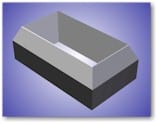CCSi manufactures these high quality Specimen Cutting Dies to evaluate three types of staining, or discoloration, that rubber may cause when in contact with, or in proximity to, another surface that may be lighter in color, as described in ASTM D925 ‘Standard Test Methods for Rubber Property — Staining of Surfaces (Contact, Migration, and Diffusion)’.
The tests provide standardized procedures for evaluating changes in the appearance of the color (staining) of a subjected surface when conditionally exposed to a given rubber material:
- Method A — Contact Stain being that change in appearance which occurs when two separate surfaces are in direct contact with one another;
- Method B — Migration Stain being that change in appearance which occurs when two separate surfaces are within a specified proximity to one another;
- Method C — Diffusion Stain being that change in appearance which occurs when two surfaces are laminated (one acting as a coating over the other), this may be referred to as a veneer, ply, co-extrusion, or bond.
Methods A & B require rectangular test specimens measuring 12 x 25 mm (1 x 0.5 inch). While Method C requires rectangular test specimens measuring 38 x 75 mm (1.5 x 3 inch).
Ask for Price

CCSi UltraLife specimen cutting dies are manufactured from homogenous, solid, high carbon content A2 tool steel. Each undergoes multi-axis precision grinding and conventional, plunge, or wire EDM (Electrical Discharge Machining) processes … producing a world-class, close tolerance die.
Precision grinding and EDM processes ensure true parallelism and multi-plane dimensional accuracy. The quality of materials, design, and engineering serve to provide the highest specimen quality possible, over an extended service life.
Where highly technical manufacturing techniques and processes end … old-world craftsmanship begins!
CCSi UltraLife specimen cutting dies are individually serialized, hand-honed, and mirror polished. A protective coating of industrial enamel is applied to the non-cutting surfaces before undergoing a rigorous final inspection.
Each UltraLife specimen cutting die includes a detailed final report and certification to the applicable standard, traceable to NIST, and compliant with ISO 9001:2000 and ISO/IEC 17025. The specimen dies are placed in a plastic, blow-molded, ‘clam shell’ style case with a foam lining to protect the die during transport and storage.
The CCSi Specimen Cutting Dies Feature:
- Exclusive UltraLife cutting edge technology;
- Designed with advanced 3D solid modeling;
- High carbon content A2 tool steel;
- Manufactured using computerized systems and techniques;
- EDM (Electrical Discharge Machining);
- CNC (Computer Numerical Control) 4 axis machining;
- Precision ground;
- Expertly honed;
- Finely polished;
- Protective industrial enamel coating;
- Plastic, foam lined, protective case;
- Traceability of dimensional measurement to NIST;
- Certification to ASTM D925;
- Compliance with ISO 9001:2000 and ISO/IEC 17025;
Available in:
- ASTM D925 Methods A & B and Method C;
- Mallet handle, arbor press mount, & press adapter versions.
| Part Number | Description | Dimensions |
| CCSi-D925-An | D925 Method A & B Die without mounting device | 12 x 25 mm (0.47 x 0.98 inch) |
| CCSi-D925-Aa | D925 Method A & B with arbor press mount | 12 x 25 mm (0.47 x 0.98 inch) |
| CCSi-D925-Ap | D925 Method A & B Die with press adapter | 12 x 25 mm (0.47 x 0.98 inch) |
| CCSi-D925-Am | D925 Method A & B Die with mallet handle | 12 x 25 mm (0.47 x 0.98 inch) |
| CCSi-D925-Cn | D925 Method C Die without mounting device | 38 ± 1.5 x 75 ±3 mm (1.5 ± 0.06 x 3 ± 0.12 inch) |
| CCSi-D925-Ca | D925 Method C with arbor press mount | 38 ± 1.5 x 75 ±3 mm (1.5 ± 0.06 x 3 ± 0.12 inch) |
| CCSi-D925-Cp | D925 Method C Die with press adapter | 38 ± 1.5 x 75 ±3 mm (1.5 ± 0.06 x 3 ± 0.12 inch) |
| CCSi-D925-Cm | D925 Method C Die with mallet handle | 38 ± 1.5 x 75 ±3 mm (1.5 ± 0.06 x 3 ± 0.12 inch) |
specimen dies, cutting dies, D925, ASTM D925, color, heat discoloration, rubber articles, rubber products, sunlamp, rubber staining, contact stain, migration stain, diffusion stain, ultraviolet discoloration, uv, Standard Test Methods for Rubber Property-Staining of Surfaces (Contact, Migration, and Diffusion).


